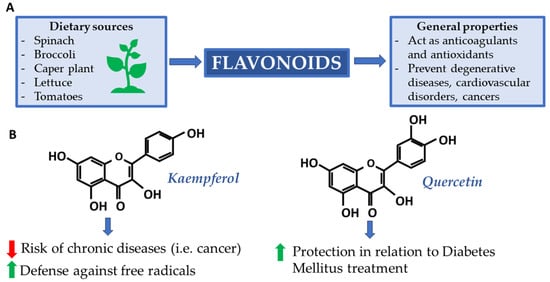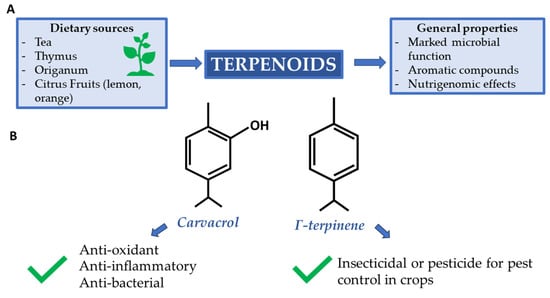You're using an outdated browser. Please upgrade to a modern browser for the best experience.
Please note this is a comparison between Version 1 by Fabio Caradonna and Version 2 by Rita Xu.
The Mediterranean diet features plant-based foods renowned for their health benefits derived from bioactive compounds.
- plant-derived compounds
- nutrigenomics
- functional food
- biofortified food
1. Introduction
Italy is one of the richest European countries in terms of plant species: in fact, this country has about half of the recognized plant species in Europe, including edible plants, which grow wild thanks to the mild climate and soil fertility. From a nutritional point of view, the healthful properties of Mediterranean species are due to a perfect balance of essential nutrients, such as vitamins and minerals, and the presence of beneficial bioactive compounds [1].
As reported in different reviews specifically focusing on their ecological, phylogenic, and evolutionary characteristics [2][3][4][2,3,4], Mediterranean plants generally consist of a complex mixture of taxa having various biogeographical origins and evolutionary histories, with approximately 50% of them considered endemic. Although very diverse, Mediterranean plants are stress-tolerant species, including evergreen trees and shrubs, semi-deciduous shrubs, geophytes, and winter annual herbs. These plants share morphological, anatomical, and phenological traits according to an evolutionary convergence driven by environmental conditions, such as climate.
In particular, rwesearchers focused theiour attention on some wild and spontaneous Mediterranean edible plants, which represent a great resource, fitting fully into nutritional plans as ingredients in many traditional culinary recipes. In particular, this researchview addresses two Mediterranean aromatic herbs (Thymus vulgaris. and Origanum vulgare) endowed with extraordinary antioxidants, antibacterial, anti-inflammatory properties [5], and at the same time, tasty ingredients for theour cuisine, and two xerophilous cultivated and naturalized drought-resistant shrubs, Opuntia ficus indica and Capparis spinosa, of promising potentialities to cope with emerging climatic change in the Mediterranean countries.
These edible wild plants are rich in many metabolites that are often referred to as secondary since they are generally not essential for the growth of the producer organism (at least under controlled conditions) and are produced in smaller quantities than the primary metabolites. However, they play a key role in the interactions between plant organisms and the biotic and abiotic environment in which plants live. In particular, it is known that secondary metabolites act as protection factors against microbial pathogens [6], facilitate reproductive processes, and act as defense mechanisms against abiotic stresses [7]. It has become increasingly clear that these compounds are involved in numerous biochemical and physiological processes and that they can play a role as protective health factors in improving plant growth and development.
In addition, polyphenols, carotenoids, and terpenes have been shown in various experimental studies to exert preventive action against chronic degenerative diseases in human beings [8] thanks to their antioxidant activity, which is mainly expressed in opposing oxidative processes.
The need, therefore, came about to draw up a diet that included these plants. The precious contribution they give to a healthy diet is schematically shown in an Eating Pyramid presented by Mantzioris and Villani [9], indicative of the purposes of complete and balanced nutrition. The pyramid is divided on the size of the sector, which indicates the frequency of intake/relative quantity ratio for each specific food depicted. According to the information presented, it can certainly be said that no restrictions are imposed regarding fruits, to which the prickly pear belongs, and spices, such as oregano and rosemary, the consumption of which is free from any restrictions. Thus, a balanced mix of healthy nutrients and benefits for human health constitutes what we commonly call the “Mediterranean diet”, a UNESCO World Heritage Site since 2010. Numerous studies link it to longevity and protective effects against several diseases, including a nutritional-epigenetic effect on cancer cells [10][11][12][10,11,12].
2. Mediterranean Edible Plant Bioactive Molecules: An Arsenal of Pigments, Flavonoids, and Terpenoids
Bioactive molecules are naturally contained in a huge number of foods, mostly plants, and are grouped into classes based on structural or biosynthetic characteristics. They can improve certain functions of the organism, which is why they are suggesting more interest in the scientific community, and can positively influence a physiological benefit and/or reduce the risk of developing certain diseases [13][14][13,14]. Secondary metabolites, which bioactive molecules belong to, are not essential for the development of the plant or the reproduction of the organism but represent useful products for beneficial purposes [15][16][15,16] or are involved in protective functions against infections [17][18][17,18] or physiological stresses like UV radiation [19]. Most plants have not yet been examined for secondary metabolites, and new compounds are being discovered day by day. It can, therefore, be said that bioactive molecules are still a rich but unexplored world that gains charm when generic bioactivity can be explicated in power to modulate gene expression in cells.2.1. Indicaxanthin: The Yellow Pigment of Prickly Pear Fruit
The prickly pear, or Opuntia ficus-indica L. Mill, is an iconic symbol of Southern Italy and holds within it a treasure of nutrients [20]. O. ficus-indica L. Mill (order Caryophyllales family Cactaceae) is native to Mexico but naturalized and widely cultivated in Mediterranean countries. Plants of this genus prefer hot and dry climates, which is why Mediterranean countries are an ideal habitat for their growth, to such an extent that they have been considered invasive in Sicily. There are many varieties of the prickly pear: it is multicolored, and the pulp can be orange, green, white, yellow, or red. The outward appearance, besides being a well-studied Physico-chemical phenomenon described above, provides a considerable quality parameter of the products. Hence, the consumer is naturally inclined to choose a more colorful product as it is more appealing. Prickly pear extracts contain a large amount of these biomolecules, which is why they have always been tested for their antioxidant capabilities, yielding promising results [21][22][21,22]. Moreover, fruits and their juices have always been recommended for their diuretic, hypoglycemic, analgesic, and anti-inflammatory effects, as well as for gastritis relief [20]. Regarding the use of the isolated molecules, there are extensive studies on betanin, which is shown to have great antioxidant activity in inhibiting lipid peroxidation of membranes [23]. Among the phytochemicals, indicaxanthin has attracted the scientific community’s attention. The molecule belongs to the family of betaxanthin of the betalain class: vacuolar pigments composed of a central nitrogenous structure, betalamic acid [24]. Betalamic acid condenses with imine compounds to form betacyanins or betaxanthins. More specifically, indicaxanthin derives from the condensation of betaine with L-proline [25]. Since it belongs to the plant pigment class, it is a light-adsorbing unit and must, therefore, be preserved from exposure to direct light to avoid damage to the structure. It is also susceptible to enzymatic reactions and temperature fluctuations. The same is said of Indicaxanthin, where researchwers note its properties as a redox agent [26], as a protector against hemolysis [27], and as a pigment capable of crossing the blood-brain barrier when administered in nutritionally relevant quantities [28]. Recent studies have also shown the role of indicaxanthin as a modulator of DNA methylation in Caco2 cells, making this molecule a good candidate for an anticancer drug [12], and its pro-autophagic potential in human colorectal cancer cells [29].2.2. Kaempferol and Quercetin: Flavonoids in Caper Plant
Flavonoids are a large class of phenolic compounds. They can exert a variety of beneficial biological activities and have proven to be fundamental for health, especially in the prevention of degenerative diseases, cardiovascular disorders, and cancers [30]. From a chemical point of view, most flavonoids consist of a core structure composed of 15 carbon atoms (C-15) distributed over three rings: two benzyls and one heterocyclic. Kaempferol (C15H10O6) and quercetin (C15H10O7) are two flavonols with very similar structures, as can be seen in Figure 1.
Figure 1. (A) Supply sources and main flavonoid properties; (B) Kaempferol and quercetin: two flavonoids renowned for their beneficial properties.
2.3. Carvacrol and γ-Terpinene: Antimicrobial Terpenoids in Oregano and Thymus
Aromatic spices such as oregano and thyme are used every day to flavor dishes of the Mediterranean diet. Both aromatic herbs, Thymus spp. and Origanum spp., belong to the order Lamiales in the family Lamiaceae. They are well known for their antioxidant effects when appropriately accompanied by cooked dishes [41][42][41,42]. Carvacrol and γ-terpinene, whose structures are shown in Figure 2, are two terpenoids that can be produced by the above-mentioned species. Carvacrol is one of the components in thyme and oregano essential oil with the highest microbial activity. It is known for its ability to inhibit flagellum development in Escherichia coli and to trigger heat shock proteins during infections [43][44][43,44].
Figure 2.
(
A
) Supply sources and main terpenoid properties; (
B
) Carvacrol and γ-terpinene are two terpenoids renowned for their beneficial properties.
